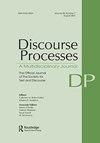礼貌与突发坏消息时的不确定性沟通
IF 2.1
2区 心理学
Q2 PSYCHOLOGY, EDUCATIONAL
引用次数: 0
摘要
摘要不确定语言可以用来表达真正的不确定性,但也可以用来管理面子(例如,软化坏消息)。这些相互冲突的动机可能会在健康沟通中产生歧义。在这个预先注册的由两部分组成的实验中,参与者扮演了健康专家的角色,并写了一封信,传达了某种或不确定的医学诊断。这是针对患者(高脸威胁)或患者的家庭医生(低脸威胁)。在高脸威胁下写的信比在低脸威胁下的信包含更多的单词和更多的反驳标记(例如,对不起,不幸的是)。明确对冲的数量(例如,可能,可能)与面部威胁的函数没有差异。只有在面部威胁较高且诊断不确定的情况下,写信所需的时间才会增加,这表明以委婉的方式传达不确定信息的共同压力增加了任务需求。我们的数据表明,参与者自发地产生了反驳标记(但不是明确的对冲)来管理面部,并且面部管理在不确定性下更为繁重。第二组参与者的评分表明,面部管理策略不会影响信息的感知意义或方式。有关打开的材质、数据和代码,请参见https://doi.org/10.17605/OSF.IO/ZU2AN.本文章由计算机程序翻译,如有差异,请以英文原文为准。
Politeness and the communication of uncertainty when breaking bad news
ABSTRACT Uncertain language can be used to express genuine uncertainty but can also be used to manage face (e.g., by softening bad news). These conflicting motivations can create ambiguity in health communication. In this preregistered two-part experiment, participants assumed the position of a health specialist and wrote a letter communicating either a certain or an uncertain medical diagnosis. This was addressed to either a patient (high face threat) or the patient’s family doctor (low face threat). Letters written under high face threat contained more words and more dispreferred markers (e.g., sorry, unfortunately) than those written under low face threat. The number of explicit hedges (e.g., possibly, maybe) did not differ as a function of face threat. Time taken to write the letters was elevated only in the condition where face threat was high and the diagnosis was uncertain, suggesting that the joint pressures of communicating uncertain information in a tactful way increased the task demands. Our data demonstrate that participants spontaneously produced dispreferred markers (but not explicit hedges) to manage face and that face management is more taxing under uncertainty. Ratings from a second set of participants indicate that face management strategies did not affect the perceived meaning or manner of the message. For open materials, data, and code, see https://doi.org/10.17605/OSF.IO/ZU2AN.
求助全文
通过发布文献求助,成功后即可免费获取论文全文。
去求助
来源期刊

Discourse Processes
Multiple-
CiteScore
4.30
自引率
4.50%
发文量
27
期刊介绍:
Discourse Processes is a multidisciplinary journal providing a forum for cross-fertilization of ideas from diverse disciplines sharing a common interest in discourse--prose comprehension and recall, dialogue analysis, text grammar construction, computer simulation of natural language, cross-cultural comparisons of communicative competence, or related topics. The problems posed by multisentence contexts and the methods required to investigate them, although not always unique to discourse, are sufficiently distinct so as to require an organized mode of scientific interaction made possible through the journal.
 求助内容:
求助内容: 应助结果提醒方式:
应助结果提醒方式:


